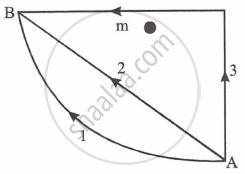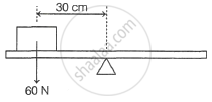Advertisements
Advertisements
प्रश्न
Answer the following question.
You are sitting next to your friend on ground. Is there any gravitational force of attraction between you two? If so, why are you not coming together naturally? Is any force other than the gravitational force of the earth coming in the picture?
उत्तर
- Yes, there exists a gravitational force between me and my friend sitting beside each other.
- The gravitational force between any two objects is given by, `vec"F" = "G" ("m"_1"m"_2)/"r"^2`
Where, G = universal gravitational constant, m1 and m2 = mass of the two objects,
r = distance between centers of the two objects - Thus, me and my friend attract each other. But due to our small masses, we exert a force on each other, which is too small as compared to the gravitational force of the earth. Hence, me and my friend don’t move towards each other.
- Apart from the gravitational force of the earth, there is the normal force and frictional force acting on both me and my friend.
APPEARS IN
संबंधित प्रश्न
Answer the following question.
In the following table, every entry on the left column can match with any number of entries on the right side. Pick up all those and write respectively against A, B, C and D.
| Name of the force | Type of the force | ||
| A | Force due to tension in a string | P | EM force |
| B | Normal force | Q | Reaction force |
| C | Frictional force | R | Conservative force |
| D | Resistive force offered by air or water for objects moving through it. | S | Non-conservative force |
Among the four fundamental forces, only one force governs your daily life almost entirely. Justify the statement by stating that force.
Answer the following question.
Distinguish between real and pseudo force.
Answer the following question.
Distinguish between contact and non-contact forces
Answer the following question.
State the formula for calculating work done by a force. Are there any conditions or limitations in using it directly? If so, state those clearly. Is there any mathematical way out for it? Explain.
Solve the following problem.
As I was standing on a weighing machine inside a lift it recorded 50 kg wt. Suddenly for a few seconds, it recorded 45 kg wt. What must have happened during that time? Explain with complete numerical analysis.
40000 litre of oil of density 0.9 g/cc is pumped from an oil tanker ship into a storage tank at 10 m higher level than the ship in half an hour. What should be the power of the pump?
Solve the following problem.
Power is the rate of doing work or the rate at which energy is supplied to the system. A constant force F is applied to a body of mass m. Power delivered by the force at time t from the start is proportional to ______.
Derive the expression for power in terms of F, m, and t.
Solve the following problem.
Derive the expression for power in terms of F, m, and t.
Solve the following problem.
Two galaxies of masses 9 billion solar mass and 4 billion solar mass are 5 million light-years apart. If, the Sun has to cross the line joining them, without being attracted by either of them, through what point it should pass?
Variation of a force in a certain region is given by F = 6x2 – 4x – 8. It displaces an object from x = 1 m to x = 2 m in this region. Calculate the amount of work done.
Two spheres of masses m and M are situated in air and the gravitational force between them is F. The space around the masses is now filled with a liquid of specific gravity 3. The gravitational force will now be ______
Two bodies A and B of equal mass are suspended from two separate massles springs of force constant k1 and k2, respectively. The bodies oscillate vertically such that their maximum velocities are equal. The ratio of the amplitudes of body A to that of body B is ______.
If W1, W2 and W3 represent the work done in moving a particle from A to B along three different paths 1, 2 and 3 (as shown in fig) in the gravitational field of the point mass 'm'. Find the correct relation between W1, W2 and W3.

In air, a charged soap bubble of radius 'R' breaks into 27 small soap bubbles of equal radius 'r '. Then the ratio of mechanical force acting per unit area of big soap bubble to that of a small soap bubble is ______.
Which of the following is the correct order of forces?
Two particles of mass m1 and m2, approach each other due to their mutual gravitational attraction only. Then ______.
A body of mass 'm' begins to move under the action of time-dependent force `vec"F" = ("t"hat"i" + 2"t"^2hat"j")`N where `hat"i" and hat"j"` are unit vectors along x and y axis respectively. The power developed by the force in watt at time 't' is ______.
What is the amount of work done by a person when
- he holds a mass of 2 kg for 5 second and
- he lifts the same mass through 1 meter to keep it on the top of a table? g = 9.8 m/s2
A force F = (10 + 0.5 x) N acts on a particle in the x-direction. The work done by the force in displacing the particle from x = 0 to x = 2 metre is ______.
Work done in sliding a 1 kg block up a rough inclined plane of height 5 m is 100 J. Work done against the friction is ______.
(g = 10 m/s2)
A Diwali cracker releases 25 gram gas per second, with a speed of 400 ms-1 after explosion. The force exerted by gas on the cracker is ______.
A gardener pushes a lawn roller through a distance of 20 m. If he applies a force of 30 kg-wt in a direction inclined at 60° to the ground, the work done by the gardener in pushing the roller is ______.
`["g" = 9.8 "m""/""s"^2, sin30^circ = cos60^circ = 1/2, cos30^circ = sin60^circ = sqrt3/2]`
Which of the following statements is correct?
A uniform beam is balanced at its mid-point an object placed on the beam as shown.

Which force will rebalance the beam?
